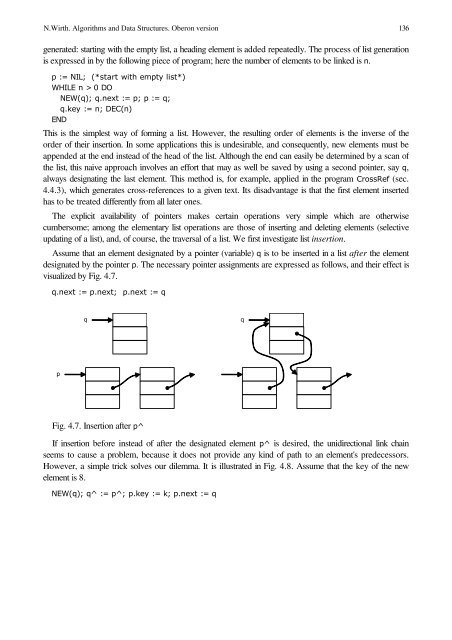Algorithms and Data Structures
Algorithms and Data Structures
Algorithms and Data Structures
You also want an ePaper? Increase the reach of your titles
YUMPU automatically turns print PDFs into web optimized ePapers that Google loves.
N.Wirth. <strong>Algorithms</strong> <strong>and</strong> <strong>Data</strong> <strong>Structures</strong>. Oberon version 136<br />
generated: starting with the empty list, a heading element is added repeatedly. The process of list generation<br />
is expressed in by the following piece of program; here the number of elements to be linked is n.<br />
p := NIL; (*start with empty list*)<br />
WHILE n > 0 DO<br />
NEW(q); q.next := p; p := q;<br />
q.key := n; DEC(n)<br />
END<br />
This is the simplest way of forming a list. However, the resulting order of elements is the inverse of the<br />
order of their insertion. In some applications this is undesirable, <strong>and</strong> consequently, new elements must be<br />
appended at the end instead of the head of the list. Although the end can easily be determined by a scan of<br />
the list, this naive approach involves an effort that may as well be saved by using a second pointer, say q,<br />
always designating the last element. This method is, for example, applied in the program CrossRef (sec.<br />
4.4.3), which generates cross-references to a given text. Its disadvantage is that the first element inserted<br />
has to be treated differently from all later ones.<br />
The explicit availability of pointers makes certain operations very simple which are otherwise<br />
cumbersome; among the elementary list operations are those of inserting <strong>and</strong> deleting elements (selective<br />
updating of a list), <strong>and</strong>, of course, the traversal of a list. We first investigate list insertion.<br />
Assume that an element designated by a pointer (variable) q is to be inserted in a list after the element<br />
designated by the pointer p. The necessary pointer assignments are expressed as follows, <strong>and</strong> their effect is<br />
visualized by Fig. 4.7.<br />
q.next := p.next;<br />
p.next := q<br />
q<br />
q<br />
p<br />
Fig. 4.7. Insertion after p^<br />
If insertion before instead of after the designated element p^ is desired, the unidirectional link chain<br />
seems to cause a problem, because it does not provide any kind of path to an element's predecessors.<br />
However, a simple trick solves our dilemma. It is illustrated in Fig. 4.8. Assume that the key of the new<br />
element is 8.<br />
NEW(q); q^ := p^; p.key := k; p.next := q
















